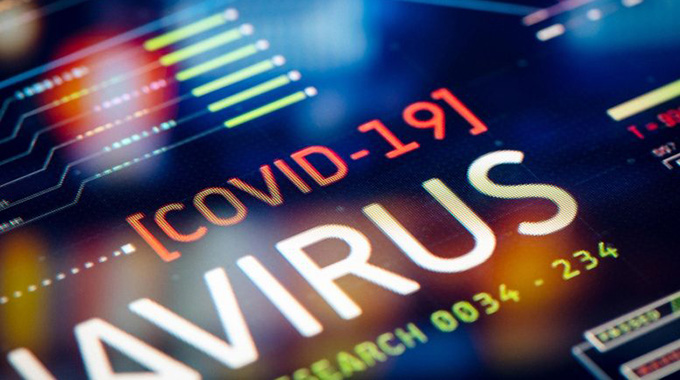COVID-19 will likely be with us forever. Here’s how we’ll live with it.

- Eventually, the virus could become a much milder illness—but for now, vaccination and surveillance are critical to end the pandemic phase.
Michael Greshko
As COVID-19 continues to run its course, the likeliest long-term outcome is that the virus SARS-CoV-2 becomes endemic in large swaths of the world, constantly circulating among the human population but causing fewer cases of severe disease. Eventually—years or even decades in the future—COVID-19 could transition into a mild childhood illness, like the four endemic human coronaviruses that contribute to the common cold.
“My guess is, enough people will get it and enough people will get the vaccine to reduce person-to-person transmission,” says Paul Duprex, director of the University of Pittsburgh’s Center for Vaccine Research. “There will be pockets of people who won’t take [the vaccines], there will be localized outbreaks, but it will become one of the ‘regular’ coronaviruses.”
But this transition won’t happen overnight. Experts say that SARS-CoV-2’s exact post-pandemic trajectory will depend on three major factors: how long humans retain immunity to the virus, how quickly the virus evolves, and how widely older populations become immune during the pandemic itself.
Depending on how these three factors shake out, the world could be facing several years of a halting post-pandemic transition—one marked by continued viral evolution, localized outbreaks, and possibly multiple rounds of updated vaccinations.
“People have got to realize, this is not going to go away,” says Roy Anderson, an infectious disease epidemiologist at Imperial College London. “We’re going to be able to manage it because of modern medicine and vaccines, but it’s not something that will just vanish out of the window.”
The long road to another common cold
One of the essential factors governing the future of COVID-19 is our immunity to the illness. Immunity to any pathogen, including SARS-CoV-2, isn’t binary like a light switch. Instead, it’s more like a dimmer switch: The human immune system can confer varying degrees of partial protection from a pathogen, which can stave off severe illness without necessarily preventing infection or transmission.
In general, the partial protection effect is one of the reasons why the four known endemic human coronaviruses—the ones that cause a common cold—have such mild symptoms. A 2013 study in BMC Infectious Diseases shows that on average, humans are first exposed to all four of these coronaviruses between the ages of three and five—part of the first wave of infections that young children experience.
These initial infections lay the foundation for the body’s future immune response. As new variants of the endemic coronaviruses naturally evolve, the immune system has a head start in fighting them off—not enough to eradicate the virus instantly, but enough to ensure that symptoms don’t progress much beyond the sniffles.
“The virus is also its own enemy. Every time it infects you, it tops up your immunity,” says Marc Veldhoen, an immunologist at Portugal’s University of Lisbon.
Past studies make clear that partial immunity can keep people from getting seriously ill, even as coronaviruses successfully enter their systems. Long-term, the same is likely to be true for the new coronavirus. Emory University postdoctoral fellow Jennie Lavine modeled SARS-CoV-2’s post-pandemic trajectory based on the 2013 study’s data, and her results—published in Science on January 12—suggest that if SARS-CoV-2 behaves like other coronaviruses, it will likely morph into a mild nuisance years to decades from now.
This transition from pandemic to minor ailment, however, depends on how the immune response to SARS-CoV-2 holds up over time. Researchers are actively examining the body’s “immunological memory” to the virus. A study published in Science on January 6 tracked the immune response of 188 COVID-19 patients for five to eight months post-infection, and while individuals varied, about 95 percent of patients had measurable levels of immunity.
“Immunity is waning, but certainly not gone, and I think this is key,” says Lavine, who wasn’t involved with the study.
In fact, it’s even possible that one of the cold-causing coronaviruses sparked a serious outbreak in the 1800s before fading into the litany of mild, commonplace human pathogens. Based on the spread of its family tree, researchers estimated in 2005 that the endemic coronavirus OC43 entered humans sometime in the late 19th century, likely the early 1890s. The timing has led some researchers to speculate that the original version of OC43 may have caused the “Russian flu” pandemic of 1890, which was noted for its unusually high rate of neurological symptoms—a noted effect of COVID-19.
“There’s no hard proof, but there are a lot of indications that this wasn’t an influenza pandemic but a corona-pandemic,” Veldhoen says.
The crucible of evolution
Though the carnage of past coronaviruses has faded over time, the road to a relatively painless coexistence between humans and SARS-CoV-2 will likely be bumpy. In the medium-term future, the impact of the virus will depend largely on its evolution.
SARS-CoV-2 is spreading uncontrollably around the world, and with every new replication, there’s a chance for mutations that could help the virus more effectively infect human hosts.
The human immune system, while protecting many of us from serious illness, is also acting as an evolutionary crucible, putting pressure on the virus that selects for mutations that make it bind more effectively to human cells. The coming months and years will reveal how well our immune systems can keep up with these changes.
New SARS-CoV-2 variants also make widespread vaccination and other transmission-blocking measures, such as face masks and distancing, more crucial than ever. The less the virus spreads, the fewer opportunities it has to evolve.
Current vaccines should still work well enough against emerging variants, such as the B.1.1.7 lineage first found in the United Kingdom, to prevent many cases of serious illness. Vaccines and natural infections create diverse swarms of antibodies that glom onto many different parts of SARS-CoV-2’s spike protein, which means that a single mutation can’t make the virus invisible to the human immune system.
Mutations may produce future variants of SARS-CoV-2 that partially resist current vaccines, however. In a preprint posted on November 19 and updated on January 19, Duprex and his colleagues show that mutations that delete parts of the SARS-CoV-2 genome’s spike protein region prevent certain human antibodies from binding.
“What I’ve learned from our own work is how deviously beautiful evolution is,” Duprex says.
Other labs have found that mutations in 501Y.V2, the variant first found in South Africa, are especially effective at helping the virus elude antibodies. Out of 44 recovered COVID-19 patients in South Africa, blood extracts from 21 of the patients didn’t effectively neutralize the 501Y.V2 variant, according to another preprint published on January 19. Those 21 people had mild to moderate cases of COVID-19, however, so their antibody levels were lower to begin with, perhaps explaining why their blood did not neutralize the 501Y.V2 variant.
So far, currently authorized vaccines—which spur the production of high levels of antibodies—seem to be effective against the most concerning variants. In a third preprint published on January 19, researchers showed that antibodies from 20 people who had received the Pfizer-BioNTech or Moderna vaccines didn’t bind quite as well to viruses with the new mutations as they did to earlier variants—but they still bound, suggesting the vaccines will still protect against severe illness.
The new variants bring other threats as well. Some, such as B.1.1.7, appear to be more transmissible than earlier forms of SARS-CoV-2, and if left to spread uncontrollably, these variants could make many more people severely ill, which risks overwhelming healthcare systems around the world and even higher death tolls. Veldhoen adds that new variants also may pose a greater risk of reinfection to recovered COVID-19 patients.
Researchers are closely monitoring the new variants. If vaccines need to be updated in the future, Anderson says that it could be done quickly—in roughly six weeks for currently authorized mRNA vaccines, such as those made by Pfizer-BioNTech and Moderna. That timetable, though, doesn’t account for the regulatory approvals that updated vaccines would need to go through.
Anderson adds that depending on how the evolution of the virus progresses, lineages of SARS-CoV-2 may arise that are distinct enough that vaccines will need to be tailored to specific regions akin to vaccines for pneumococcus. To successfully guard against SARS-CoV-2 going forward, we will need a global monitoring network similar to the worldwide reference laboratories used to collect, sequence, and study variants of influenza.
“We’re going to have to live with it, we’re going to have to have constant vaccination, and we’re constantly going to have to have a very sophisticated molecular surveillance program to keep track of how the virus is evolving,” Anderson says.
The promise and challenge of widespread vaccination
Experts agree that transitioning beyond a pandemic depends on the prevalence of immunity, especially among older and more vulnerable populations. Younger people, especially children, will build up immunity to SARS-CoV-2 over a lifetime of exposure to the virus. Today’s adults have had no such luxury, leaving their immune systems naive and exposed.
The exact threshold for achieving population-wide immunity that slows down the virus’s spread will depend on how contagious future variants become. But so far, research of early variants of SARS-CoV-2 suggest at least 60 to 70 percent of the human population will need to become immune to end the pandemic phase.
This immunity can be achieved in one of two ways: large-scale vaccination, or recovery from natural infections. But achieving widespread immunity through uncontrolled spread comes at a terrible cost: hundreds of thousands more deaths and hospitalizations around the world. “If we don’t want to push forward vaccines and champion vaccines, we have to decide collectively how many old people we want to die—and I don’t want to be the one making that decision,” Duprex says.
Jeffrey Shaman, an infectious diseases expert at Columbia University, points out that the global push for vaccines also exposes existing inequities in global health. In a widely shared map from December, The Economist Intelligence Unit estimated that rich countries such as the U.S. will have widely accessible vaccines by early 2022, which may not happen for poorer countries in Africa and Asia until as late as 2023.
Efforts to vaccinate the developing world hinge, in part, on vaccines that can be stored with standard refrigeration, such as the vaccines under development by Oxford/AstraZeneca and Johnson & Johnson. (See the latest on COVID-19 vaccine development around the world.)
As of the week of January 18, according to a World Health Organization estimate, some 40 million COVID-19 vaccine doses have been administered around the world, mostly in high-income countries. In Africa, only two countries, Seychelles and Guinea, have started providing vaccines. And in Guinea, a low-income country, only 25 people have received doses.
“Vaccine hoarding [in rich countries] will only prolong the ordeal and delay Africa’s recovery,” Matshidiso Moeti, WHO’s regional director for Africa, said in a statement. “It is deeply unjust that the most vulnerable Africans are forced to wait for vaccines while lower-risk groups in rich countries are made safe.”
As the vaccines roll out piecemeal worldwide, countries likely will issue a patchwork of vaccine mandates and certification requirements for international travelers. If the virus becomes endemic and ultimately spreads similar to common colds, however, vaccines might not be necessary forever, Lavine says.
But even researchers’ best projections run into the foggy uncertainty separating the present from the future. Questions of reinfection, transmission, the post-pandemic health burden, and viral evolution will play out for years or even decades.
“It’s going to take time, unfortunately,” Shaman says. “Time is the only thing that can tell us.”- National Geographic









Comments